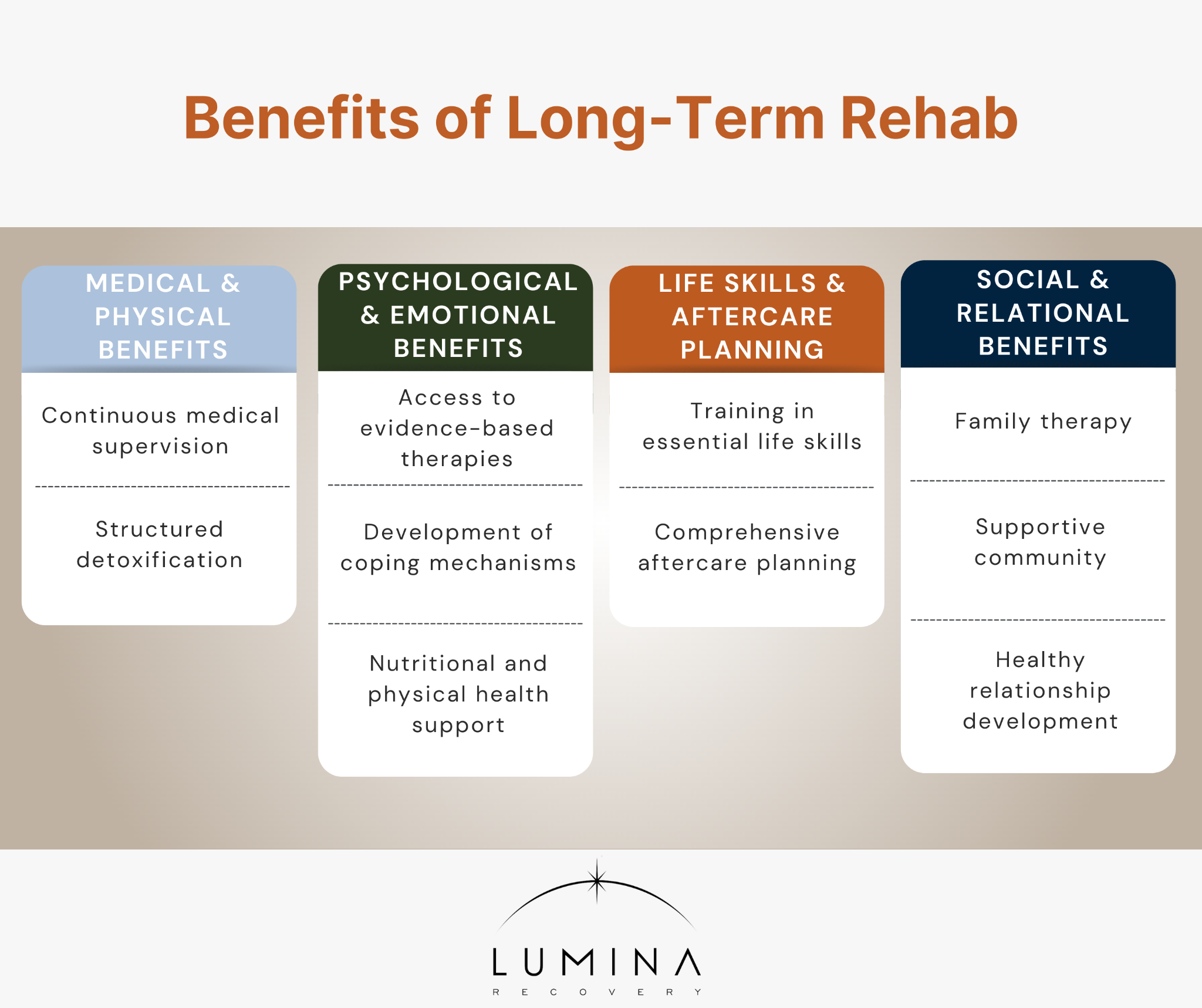Long-term rehab programs provide a structured, extended approach to addiction treatment, focusing on sustained recovery and comprehensive support.
Unlike short-term programs, which offer immediate but limited assistance, long-term rehab extends beyond 90 days to help individuals build lasting coping strategies and develop healthier lifestyles.
The benefits of long-term rehab include higher success rates, deeper emotional and psychological healing, and improved relapse prevention.
What Are Long-Term Rehab Programs?
Long-term rehab programs provide safe and secure environments where individuals receive medical care, therapy, and support over an extended period, typically lasting 90 days or more. The benefits of rehab ensure a deeper focus on recovery, allowing for gradual healing and skill development.
Types of Long-Term Rehab
- Inpatient/residential programs are for individuals who live at the treatment facility, receiving 24/7 medical and emotional support.
- Outpatient programs are for individuals who continue their daily responsibilities while attending regular therapy sessions and medical check-ins.
Benefits of Long-Term Rehab
Long-term rehab provides a wide range of benefits that support individuals in achieving and maintaining sobriety. Rehab benefits extend beyond initial detox, focusing on medical care, emotional well-being, social relationships, and long-term recovery planning.
Medical and Physical Benefits
- Continuous medical supervision. Long-term programs provide ongoing medical oversight, ensuring safe detoxification and withdrawal.
- Structured detoxification. A professionally monitored detox helps ease withdrawal symptoms and reduces health risks. This is one of the key advantages of drug treatment that supports long-term recovery.
Psychological and Emotional Benefits
- Access to evidence-based therapies. Long-term rehab includes therapies like cognitive behavioral therapy (CBT), dialectical behavior therapy (DBT), and eye movement desensitization and reprocessing (EMDR) to address the root causes of addiction.
- Development of coping mechanisms. Patients learn how to manage stress, triggers, and emotional distress without resorting to substance use.
- Nutritional and physical health support. Many programs incorporate balanced nutrition and exercise to promote overall well-being during recovery.
Life Skills and Aftercare Planning
- Training in essential life skills. Long-term rehab teaches financial management, employment skills, and self-care practices to support independent living.
- Comprehensive aftercare planning. Programs include relapse prevention strategies, sober living arrangements, and ongoing therapy options.
Social and Relational Benefits
- Family therapy. Many programs offer family therapy sessions to repair relationships and improve communication between loved ones.
- Supportive community. Peer support in rehab fosters accountability and shared experiences that contribute to recovery.
- Healthy relationship development. Long-term rehab provides opportunities to learn and practice healthy relationship skills that help individuals rebuild trust and establish positive connections.
Addressing Underlying Issues
Many individuals with addiction also struggle with mental health disorders such as anxiety, depression, or PTSD. Long-term rehab allows for thorough diagnosis and treatment of these co-occurring conditions.
Unresolved trauma often contributes to addiction. Trauma-focused therapies in long-term rehab help individuals process past experiences in a safe environment.
Statistics Supporting Long-Term Rehab
Understanding the success rates and benefits of long-term drug rehab can help individuals make informed decisions about their recovery journey. Research consistently shows that extended rehabilitation significantly improves recovery outcomes and reduces relapse rates. However, data on long-term recovery remains limited, making continued research essential.
- 68-71% of women in treatment for six months or more maintained abstinence1
- Nearly 1 in 10 adults in the U.S. has resolved a significant alcohol or other drug problem, and half of those individuals identify as being “in recovery”2
- 1% of adults in the U.S., or approximately 27.5 million people, have experienced a substance use problem in their lifetime, and 74.8% of them, or 20.5 million adults, are in recovery or have recovered from addiction2
Choosing the Right Long-Term Rehab Program
Selecting the right rehab program is crucial for achieving sustainable recovery. With various options available, it’s important to consider factors that ensure comprehensive care and long-term success.
- Accreditation and Licensing: Ensure that the rehab facility is accredited and licensed to adhere to high-quality care standards and evidence-based treatment methods.
- Individualized Treatment Plans: Look for programs that offer personalized treatment approaches tailored to individual needs, including therapies for co-occurring mental health conditions.
- Supportive Environment and Resources: A positive recovery environment plays a critical role in rehabilitation. Choose facilities that provide comfortable accommodations, holistic therapies, and access to professional support.
- Continuum of Care and Aftercare Services: Long-term success depends on continued support after rehab. Choose a program that offers structured aftercare, including outpatient services, sober living options, and relapse prevention strategies.
By evaluating these factors, individuals can make informed decisions and maximize the benefits of long-term rehab, leading to lasting sobriety and improved well-being.
FAQs
What is considered long-term rehab?
Long-term rehab typically lasts 90 days or longer and focuses on deep healing and sustainable recovery.
How does long-term rehab differ from short-term rehab?
The length of rehab programs varies based on the treatment needed. Short-term rehab lasts 30 to 60 days, primarily focusing on detox and initial therapy. Long-term rehab provides extended support for lasting change.
What are the success rates of long-term rehab programs?
Individuals who complete long-term rehab have a significantly higher chance of maintaining sobriety compared to those in shorter programs. One study found that 68-71% of women in treatment for six months or more maintained abstinence.1
Are long-term rehab programs covered by insurance?
Many insurance providers offer coverage for long-term rehab. It is advisable to check with the rehab facility and your insurance company for specific details.
What should I look for when choosing a long-term rehab facility?
Consider accreditation, individualized treatment plans, professional staff, amenities, and success rates when selecting a program.
Transform Your Life With Long-Term Rehab at Lumina Recovery
Long-term rehab provides a structured, comprehensive approach to overcoming addiction by addressing physical, emotional, and social challenges. With extended care, individuals gain the necessary coping skills, rebuild relationships, and prepare for a successful, substance-free future.
At Lumina Recovery, we offer residential inpatient treatment for immersive healing and dual diagnosis care to address co-occurring mental health disorders such as anxiety, PTSD, and depression. Our dedicated team provides individualized treatment to help you achieve lasting recovery.
If you or a loved one is struggling with addiction, take the first step toward a healthier, sober life. Contact Lumina Recovery today to explore your options.
Sources:
- Greenfield L, Burgdorf K, Chen X, et al. Effectiveness of long-term residential substance abuse treatment for women: findings from three national studies. Am J Drug Alcohol Abuse. 2004 Aug;30(3):537-50. doi: 10.1081/ada-200032290.
- National Research Institute. “We do recover”: More evidence that tens of millions of adults in the United States have recovered from a substance use problem.




